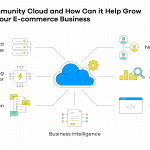
A barcode combines a series of numbers or alphanumeric characters accompanied by a scannable code. This code can be a series of parallel bars of different widths (1D barcode) or a square of smaller black-and-white squares (2D barcode).
Optical scanning devices can quickly read and translate the barcode patterns into their respective alphanumeric values, which can then be useful in a wide variety of functions. For an omnichannel ecommerce retailer, barcodes are critical components of many different internal and external workflows.
This is primarily because scanning a barcode is faster and more accurate than relying on any other form of manual data reading and recording. As such, barcode technology provides an inexpensive and effective way to identify, count, process, and track just about anything within your ecommerce business.
1D Barcodes: Different Types and Their Omnichannel Ecommerce Use Cases
1D barcodes are the traditional vertical bar patterns found on nearly every product you see on a store shelf. 1D barcodes are read by laser scanners that can interpret the contrasting dark lines and spaces between them as a series of letters and numbers.
These linear barcodes have existed since the 1950s. They have proven to be a time-tested way to label and quickly identify products within organizations, on warehouse racks, retail shelves, and at point of sale (POS).
There are a variety of different 1D barcode standards that are typically tied to specific industries and use cases. Some allow using letters and numbers, while others can only encode numeric combinations. Other types, like the Code128 standard, allow all 128 ASCII characters to be included in a 1D barcode.
Barcodes can also differ dramatically in character length. A single barcode can represent several characters to as many as 85 characters. This versatility is important as barcodes typically require a high degree of specificity to be useful.
In retail, the two most widely used 1D barcode types are UPC (Universal Product Code) and EAN (European/International Article Number). In each of these product-focused barcode standards, products are assigned unique codes for every product, variety, and style.
For example, a company selling travel mugs would need a unique UPC barcode for each size, shape, and color. This would allow customers to quickly scan a product and identify its exact nature.
UPC Barcodes
UPC barcodes are 12-digit codes made up of three different groups of numbers. The first 6-10 digits identify the unique company prefix that connects the product to its manufacturer (more on this later). The remaining digits are the unique item reference numbers assigned by the retailer or manufacturer to indicate specific products and their variations.
Sometimes, the first and last digits are used as identifiers and checksums to ensure proper readings. UPC barcodes that conform to this format are classified as UPC-A. UPC-E is a shorter barcode version that eliminates unnecessary characters and digits (usually zeroes). The result is a tighter pattern that can fit on smaller products and packaging.
EAN-13 and EAN-8 Barcodes
EAN-13 and EAN-8 barcodes are to Europe what UPC barcodes are to North America. EAN-13 is the most common of the two as its 13 digits allow for more possible combinations and permutations than the eight digits used in EAN-8 barcodes.
The first 2-3 digits of an EAN-13 barcode are identifiers usually tied to the product country and/or the product type. This is followed by a 4-5 digit unique company prefix, a 5-digit unique product code, and a final checksum digit.
The EAN-8 is similar to the UPC-E in that it offers a condensed barcode alternative for smaller products and packaging where an EAN-13 barcode would be too large.
ITF-14 Barcodes
Another especially useful 1D barcode in omnichannel ecommerce is the ITF-14 barcode. ITR-14 barcodes are used to identify cartons containing multiple products. These 14-digit codes can be printed on labels or directly onto corrugated cardboard, allowing you to quickly scan a carton and identify the products and quantities inside.
For cartons that contain a quantity of the same product and variety (for example, multiple items with the same UPC or EAN), the ITF-14 contains the same company prefix and item reference numbers as the UPCs of the products inside the carton. The remaining characters are used to classify the packaging type and quantity data of the carton.
However, when a carton contains several different products and/or varieties, an entirely new ITF-14 must be created to reflect the unique contents. In most cases, the scanners and software used to read one of these retail-focused barcodes can read the others.
Descartes Sellercloud and Skustack fully support UPC, EAN, and ITF-14 barcode standards.
Where Barcodes Come From and Why It Matters
While it is possible to simply create and assign barcodes for internal use, there are certain standards that you must adhere to when assigning barcodes like UPCs, EANs, ITF-14s, and shipment tracking codes that are used by third parties to scan and identify your products.
For your store or warehouse, it is fine to generate a string of characters and encode them with a barcode pattern. However, it can lead to misidentified items or conflicts with other brands and products should you attempt to use these self-made barcodes in other retail environments.
To avoid the problem of conflicting barcodes, an entire industry is focused solely on creating, assigning, and sharing barcode information. The organization at the center of it all is Global Standards 1 (GS1).
GS1 is an international, neutral, non-profit organization at the forefront of barcode creation and standardization since 1974. They are the custodians of the Global Trade Item Number (GTIN), which helps connect every registered product to a guaranteed unique code that can be used as an identifier by organizations worldwide.
To achieve this level of standardization, businesses must register with GS1 to receive their unique company prefix, which will be used at the beginning of every product barcode. This prefix is essential in establishing and verifying brand ownership.
The GS1 Data Hub (either US or international) then allows members to create and purchase barcodes and register the corresponding products. Individual GTINs can also be purchased and registered without opting for a company prefix. This is a cost-effective and convenient option for businesses with smaller product lines or those needing to create one-off barcodes, such as an ITF-14, for a particular carton.
GTINs are a requirement for listing on most ecommerce marketplaces. They help establish product legitimacy, prevent duplicate listings, and improve order accuracy. Walmart, Amazon, and Google Merchant Center all have their own policies about GTIN requirements and enforcement.
In addition, Amazon requires a GTIN to participate in its transparency anti-counterfeiting program.
2D Barcodes: Different Types and Their Omnichannel Ecommerce Use Cases
2D barcodes have been around since the 1980s, but they have become more ubiquitous since the advent of the smartphone. These matrices of black and white squares can represent thousands of characters (exponentially more than 1D barcodes), but they require optical scanners that are more complex than the laser scanners used to scan a UPC.
However, the same digital camera technology found in smartphones is capable of scanning and reading a 2D barcode. This means that most of your customers already possess the technology needed to benefit from this technology, and you can also provide your own team members with scanning technology that is likely already familiar to them.
The additional data that can be encoded into a 2D barcode can be especially useful for ecommerce businesses in many ways. Details like expiration dates, batch and lot identifiers, bin locations, and fulfillment instructions can be encoded on product labels so that they can be retrieved by associates with a quick scan.
Similarly, bins, racks, and warehouse equipment can be labeled so that workflow and storage information can be accessed quickly. Odds are, many of the omnichannel partnerships you currently rely on involve 2D barcodes already. Most major shipping providers, 3PL businesses, and POS systems have 2D barcode functionality integrated into their workflows and products.
2D barcodes have tremendous customer-facing benefits as well. Since every smartphone has a camera and connectivity to act as an optical scanner, you can leverage QR codes and DataMatrix symbols to provide customers with web-enhanced product experiences.
These can include links to things like product manuals, video guides, warranty information, your webstore, or customer support. Public awareness of 2D barcodes continues to grow (a floating QR code was one of the most talked-about Super Bowl ads), which means their viability and usefulness will continue to increase.
There are several types of 2D barcodes:
DataMatrix Symbols
DataMatrix symbols can store up to 3,116 numbers or a combination of 2,335 numbers and letters. These 2D barcodes are the simplest type and can be read by even the simplest 2D barcode optical scanning devices.
MaxiCode Symbols
MaxiCode symbols are easily identified as each has a characteristic bullseye inside a one-inch square matrix. While each matrix can only store 93 characters of information, multiple MaxiCodes can be placed together in a chain to store even more information. This is the 2D barcode of choice for UPS.
QR Codes
QR Codes look similar to DataMatrix symbols, but they have a significantly higher data capacity: 7,089 numeric characters or 4,296 alphanumeric characters. QR Codes are easily identifiable thanks to their characteristic square-in-a-square symbols in each corner (used to help scanners account for orientation, angle, and surface curvature).
DotCode
DotCode is a more flexible 2D barcode comprising a matrix of dots instead of squares. DotCode supports the entire ASCII character set, making it a versatile form of scannable data storage. Most DotCode barcodes are seven dots high, but there is theoretically no maximum capacity beyond what scanning technology can capture.
Barcodes Require The Right Mix of Hardware and Software to Be Useful to Ecommerce Businesses
Whether you use 1D barcodes, 2D barcodes, or a combination thereof, you must have the proper equipment to scan them. On the backend, you need software that can make sense of the barcode data and use it to support efficient and reliable workflows.
Skustack is Descartes Sellercloud’s revolutionary WMS (Warehouse Management System). It is built upon patented technology, using intuitive scanners and a robust software platform to take your warehouse optimization to the next level. Barcodes are infused throughout the WMS, allowing for accurate inventory tracking, transfers, picking, and packing.
Skublox is another example of how barcodes can streamline everyday ecommerce functions. Team members can scan barcodes on products and bins to ensure that the right items are added to the right orders before they are packed, labeled, and shipped to customers.




